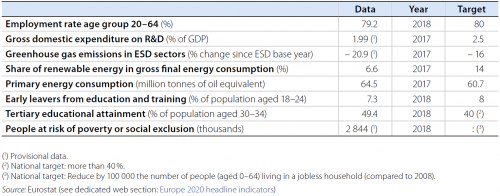Archive:Europe 2020 indicators - Netherlands
Data extracted in August 2019.
No planned update.
This Statistics Explained article is outdated and has been archived - for recent information on Europe 2020 strategy see here.

Source: Eurostat (see dedicated web section: Europe 2020 headline indicators)
Explanations on this radar chart are available here.
This article is part of a set of statistical articles on Europe 2020 strategy, focusing on the situation in the Netherlands.
Full article
Overview
The Netherlands had already exceeded its target on tertiary educational attainment in 2010 and the share of 30- to 34-year-olds with tertiary educational attainment has continued to rise. In 2018, the country also exceeded its national targets on early leavers from education and training by 0.7 percentage points. Due to a steady increase in its employment rate since 2015, the Netherlands was just 0.8 percentage points from its national employment target in 2018. Since 2008, the country has also moved closer to its target on R&D expenditure than the EU has to its overall target. In contrast, the Netherlands was the country furthest from its renewable energy target and still had to close a 3.8 Mtoe gap to reach its primary energy consumption target. Nevertheless, the country surpassed its target on reducing GHG emissions in ESD sectors by 4.9 % in 2017. The situation concerning the number of people at risk of poverty or social exclusion has deteriorated since 2008. However, it is not possible to make a comparison with the national target as it refers to people aged 0 to 64 living in a jobless household.

Source: Eurostat (see dedicated web section: Europe 2020 headline indicators)
Data sources
More information about the origin of the data and the calculation of indicators can be obtained via the Europe 2020 indicators dedicated website.
Under 'Main tables', click on the icons next to the indicators:
- 'Explanatory texts (metadata)' for a detailed overview of the collection and compilation methods;
- 'Information on the leaf' for data availability per country.
A more general overview of quality procedures can be found in Implementation of standard reference metadata for indicators - the ESMS Indicator Profile (ESMS-IP) (PDF file).
Context
Europe 2020 is the EU’s agenda for jobs and growth for the current decade. It emphasises smart, sustainable and inclusive growth as a way to strengthen the EU economy and prepare its structure for the challenges of the next decade. As a main objective, the strategy strives to deliver high levels of employment, productivity and social cohesion in the Member States, while reducing the impact on the natural environment.
Direct access to
- Towards robust quality management for European Statistics - Communication from the Commission to the European Parliament and the Council COM(2011) 211 final.
- Regulation (EC) No 223/2009 of 11 March 2009 on European statistics